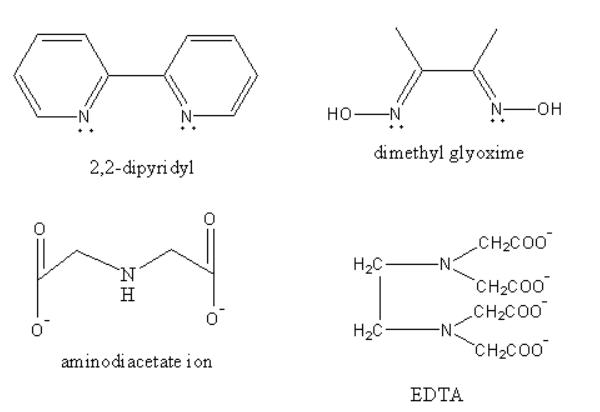
Which is the example of the hexadentate ligand?
A.
B. Dimethylglyoxime
C. Iminodiacetate ion
D. Ethylene diamine tetra acetate ion (EDTA)
Answer
480.6k+ views
Hint:We can determine the denticity by counting the number of donor atoms of a ligand. The prefix ‘Hexa’ in hexadentate denotes the six. The ligand which has six donor atoms is known as a hexadentate ligand.
Complete answer:
Ligand is a molecule that binds with metal to form a complex. The molecule binds with metal with some of its atoms. Denticity of a ligand is defined as the number of donor atoms of a ligand.
The ligands which bind with metal through a single atom are known as unidentate ligand such chloro
The ligands which bind with metal through two atoms are known as bidentate ligand such ethylene diamine
The ligands which bind with metal through six atoms are known as a hexadentate ligand. The ligands which bind with metal through three or more atoms are known as the polydentate ligand.
We will draw the structure of all ligand to determine their denticity as follows:

The ligand
Therefore option (D) Ethylene diamine tetra acetate ion (EDTA) is correct.
Note:
The atoms which donate electrons to the metal are the donor atoms of the ligand. The donor atoms have a negative charge or lone pair of electron. The ethylene diamine has two hydroxyl groups but these oxygen atoms cannot work as donor atoms due to steric factors. Similarly, the two oxygen atoms in iminodiacetate ions also cannot work as donor atoms.
Complete answer:
Ligand is a molecule that binds with metal to form a complex. The molecule binds with metal with some of its atoms. Denticity of a ligand is defined as the number of donor atoms of a ligand.
The ligands which bind with metal through a single atom are known as unidentate ligand such chloro
The ligands which bind with metal through two atoms are known as bidentate ligand such ethylene diamine
The ligands which bind with metal through six atoms are known as a hexadentate ligand. The ligands which bind with metal through three or more atoms are known as the polydentate ligand.
We will draw the structure of all ligand to determine their denticity as follows:

The ligand
Therefore option (D) Ethylene diamine tetra acetate ion (EDTA) is correct.
Note:
The atoms which donate electrons to the metal are the donor atoms of the ligand. The donor atoms have a negative charge or lone pair of electron. The ethylene diamine has two hydroxyl groups but these oxygen atoms cannot work as donor atoms due to steric factors. Similarly, the two oxygen atoms in iminodiacetate ions also cannot work as donor atoms.
Recently Updated Pages
Master Class 9 General Knowledge: Engaging Questions & Answers for Success

Master Class 9 English: Engaging Questions & Answers for Success

Master Class 9 Science: Engaging Questions & Answers for Success

Master Class 9 Social Science: Engaging Questions & Answers for Success

Master Class 9 Maths: Engaging Questions & Answers for Success

Class 9 Question and Answer - Your Ultimate Solutions Guide

Trending doubts
Give 10 examples of unisexual and bisexual flowers

Draw a labelled sketch of the human eye class 12 physics CBSE

Differentiate between homogeneous and heterogeneous class 12 chemistry CBSE

Differentiate between insitu conservation and exsitu class 12 biology CBSE

What are the major means of transport Explain each class 12 social science CBSE

What is the difference between resemblance and sem class 12 social science CBSE




